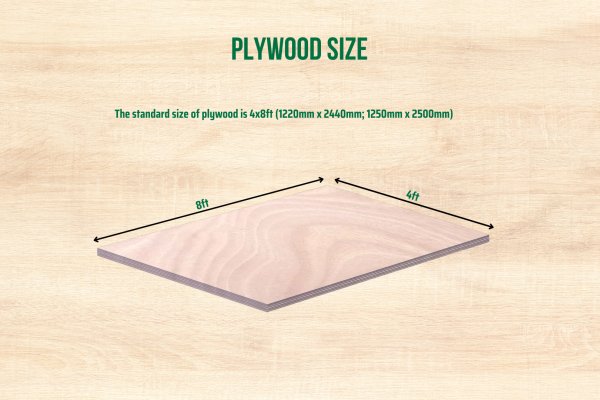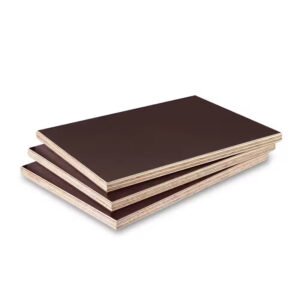

Guide to Choosing the Best Suitable Size and Thickness of Plywood for Each Type of Project
Table of Contents
ToggleProbably the most popular in the number of engineered wood products, plywood consists of several thin layers of wood or veneers bonded together with strong adhesives. As a result, such an unprecedented combination of durability, lightness, and versatility has widely popularized plywood among builders, who use this material in the widest spectrum of projects-from simple interior furnishings to great, full-scale constructions. However, to effectively exploit the advantages offered by plywood, its correct size and thickness of plywood should be carefully chosen with regard to the job to be performed.

Quality and safety depend on the proper choice of plywood. Using the wrong size and thickness of plywood can create weaknesses in the structure, aesthetic problems, or cost a fortune to repair later on. Available on the market in many sizes and thicknesses, informed selection will optimize both performance and cost-effectiveness.
Why Plywood Size and Thickness Are Important
The size and thickness of plywood will have a direct impact on factors relating to the load that it can bear, its durability, and aesthetic appeal of the project. Here is why choosing the right size and thickness of plywood is important:
- Durability and Structural Safety: Thicker plywood panels offer higher structural solidity that may be used in load-bearing projects, for instance, flooring or wall installations.
- Aesthetic Appeal: Larger sheets mean fewer seams, adding a clean, cohesive appearance to interior applications ranging from wall cladding to cabinetry.
- Cost Savings: Correct size and thickness of plywood prevents pre-construction waste and reduces material costs, thus saving money that will be spent on future repairs or replacement.
Common Plywood Size and Thickness of Plywood for Selection
Standard sizes for plywood sheets are normally 1220 x 2440 mm, though there are projects requiring larger and smaller sheets. When planning your project, consider the following common plywood sizes:
- 1220 x 2440 mm (4×8 feet): This size is widely used for many types of indoor and outdoor applications. It’s suitable for flooring, cabinetry, wall paneling, and various interior structures.
- 1525 x 3050 mm (5×10 feet): This sheet size opens wide possibilities when projects demand broad, seamless surfaces-ranges from wall coverings to giant furniture pieces or structural applications that reduce the need for joints, with an added advantage of improved durability.

plywood size
Thickness of plywood can range normally from 3mm through to well over 25mm. The thickness will affect the strength and flexibility, and overall weight of the plywood. Here’s a breakdown of common plywood thicknesses and their ideal uses:
- 5mm – 6mm: This thin plywood is ideal for decorative applications, such as wall cladding or lightweight partition walls. Due to its light weight and flexibility, it is easy to work with and finds applications in designs that do not require heavy load-carrying.
- 9mm – 12mm: This would serve as an ideal plywood thickness for furniture, shelving, and medium-load applications. It strikes a good weight-to-strength ratio, making it pretty easy to handle for projects such as cabinetry or wall shelving.

Size and thickness of plywood is really important - 15mm – 18mm: It is normally used for flooring, kitchen cabinets, and structural walls because this thickness offers substantial mass that can resist heavy traffic and load.
- 20mm and above: The category of plywood thicker than 20mm is usually applied outdoors for mezzanine floors or any other load-carrying application and is subjected to harsh environmental conditions. This thickness has better stability, impact resistance, and weather durability.
How to Choose the Right Size and Thickness for Specific Projects
- Decorative Interior Elements and Wall Cladding: In this case, for the lights inside elements that will be used for paneling or some other kind of decorative installation, it would be quite enough to use plywood 5-6 mm thick. Within this thickness, plywood becomes easily cut and ground without obtaining ample weight after treatment.
- Cabinetry and Shelving: Cabinets, wall-mounted shelves, and interior furnishings demand moderate load-bearing strength; plywood within the range of 9-12mm would be suitable. It provides rigidity with a sufficiently low overall weight.

plywood for outdoor projects - Flooring and Structural Walls: Whenever the issue at hand requires high-strength purposes, such as when floors or walls are needed to have added durability, then one should choose plywood with thicknesses ranging from 15-18mm. The thickness is ideal for bearing loads with high intensity and also resists bending and warping over a certain period of time
- Outdoor or Heavy-Load Applications: Those that, for example, are exposed to open air and those with higher carrying loads, such as in the case of staircases, mezzanine floors, and outdoor furniture, for instance, require plywood above 20 mm in thickness. This will make it strong and make the material stable against elements in the environment like moistures, sunlight, and temperature changes.
Additional Considerations for Choosing Size and Thickness of Plywood
- Environmental Exposure: For this purpose, one should use water-resistant or treated plywood so that the wood does not soak any kind of moisture and change in weather. This protection will further increase durability and minimize the risk of any damage or decaying.
- Project Budget: Thicker plywood is more expensive, though in most projects it ends up earning its price in longevity and lower maintenance.
- Specific Structural Requirements: The load-carrying demand differs between one job and another. For light decorative work, thin plywood will be enough, while for structural work, use size and thickness of plywood enough to carry the expected load.

Many factors need to be considered when choosing plywood
Special Types of Size and Thickness of Plywood for Unique Applications
Specialty types of plywood include those that have special features that make them particularly well-suited for specific applications:
- Waterproof Plywood: This type of plywood contains additional water-resistant treatments and is ideal for outdoor projects; it basically serves to help the wood resist dampness and decay.
- Fire-resistant Plywood: Fire-resistant plywood is made with treated surfaces that help impede the spread of flames and has been used in many public and commercial buildings for that purpose.
- Veneered Plywood: These natural finished wood veneers have been used in mostly very expensive furniture and other interior designs to give it that classy appeal.

Fire-resistant plywood
Surface Finish Considerations
The quality and type of surface finish will enhance both its appearance and durability. If you have projects in which a polished or decorative finish is a critical factor, then consider plywood that has a veneer or pre-treated surface for easy painting, varnishing, or other finishes.
Key Points for Effective Size and Thickness of Plywood
- Load Capacity: Determine how much weight will be applied to your plywood. The heavier the load, the thicker the plywood must be for structural and floor plywood purposes.
- Weather Resistance: Projects outside should, therefore, be made from plywood treated for the weather to overcome moisture challenges.
- Budget Constraints: Know what type and size of plywood is needed, finding a balance between the job requirements and cost in terms of durability/quality.

You should balance the criteria to choose the right type of plywood
Final Tips for Optimizing Your Size and Thickness of Plywood
- Quality Over Cost: The use of high-quality plywood invests in stability and durability that, more often than not, promotes savings over the long term.
- Choose the Right Supplier: Purchase from good and trusted suppliers that would provide you with an accurate and well-manufactured plywood product for your needs. Good suppliers can provide expert advice on the most suitable size and thickness of plywood to be used.
Conclusion
The usability mainly lies in the right size and thickness of plywood that will best be suited for either construction or interior purposes. In essence, the knowledge of the particular needs within each application will eventually allow you to select one with dimensions that suit the demands in terms of strength, aesthetics, and cost.
Are you looking for high-quality plywood? With a wealth of experience, HPC is able to provide a wide range of high-standard products. Contact us today for more information and discover the perfect pieces for your customers!

Contact us
Leave us a message for request about our commercial wood supply
